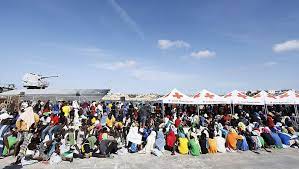EU migration reform enters final stretch. Here’s what you need to know

Brussels: The European Union is inching closer to reforming its migration policy, a once-in-a-generation opportunity to establish consistent rules for all member states. But there’s still work to do before reaching the finish line.
The reform is an intricate set of five interlinked pieces of legislation known as the New Pact on Migration and Asylum.
Despite its name, the Pact is barely new: it was presented by the European Commission in September 2020 as one of the flagship proposals of President Ursula von der Leyen and quickly became the subject of intense media scrutiny, both due to its innovative nature and the acrimonious debate it has prompted among EU leaders.
The Pact is intended to be a holistic, all-encompassing legal framework that can turn the page on the ad-hoc crisis management of the past decade, which saw countries take unilateral and uncoordinated measures to cope with the arrival of asylum seekers.
These go-it-alone policies severely undermined the Union’s collective decision-making and often made Brussels look like an inconsequential bystander in what is arguably the most politically explosive issue on the agenda.
“Migration is a European challenge that requires a European response,” Ursula von der Leyen has said numerous times.
The Pact envisions precise and predictable rules that lay out the tasks for member states and the EU institutions in normal and exceptional conditions so that nobody has the need to ask “what now?” every time an external border comes under pressure.
The ultimate goal is to strike the perfect balance between the responsibility of frontline nations, like Italy, Greece and Spain, which are the ones that receive the bulk of asylum seekers, and the principle of solidarity that other countries should uphold.
The draft laws undergo the ordinary legislative procedure: the European Parliament and the EU Council first agree on their separate positions and then meet together to thrash out a compromise text. After that, the new text has to be approved by the two institutions: first lawmakers and later, member states.
Following a “nothing is agreed until everything is agreed” mantra, progress has been painfully slow. But a fresh political impetus earlier this year has reinvigorated hopes that the whole package could be concluded before the 2024 European elections.
These two are the most technical pieces of legislation and are generally considered the “least controversial” of the Pact, making them the likeliest to be wrapped up first.
The Screening Regulation envisages a pre-entry procedure for a rapid examination of an asylum seeker’s profile. It will apply to non-EU nationals who irregularly cross into the bloc’s territory, who are brought ashore as part of a search-and-rescue operation, or who are detained after having eluded border controls.
The procedure will collect information about the migrant’s identity, fingerprints and facial image, together with health, security and vulnerability checks. It should not last more than five days. Once all the details are gathered, the national authorities will be able to decide the next step in the asylum process.
The biometric evidence will be stored in European Dactyloscopy (Eurodac), the EU’s large-scale database that allows countries to verify new asylum requests against those that have been registered in the past. Eurodac has been in place since 2003 and is used by the 27 member states, Iceland, Norway, Switzerland and Liechtenstein.
The main change under the amended Eurodac Regulation is a shift in focus from counting individual applications to counting individual applicants. In theory, this will help authorities recognise previous claimants, prevent refugees from moving across countries, and speed up the return of those whose requests are rejected.
State of play: the Council endorsed its mandate on both regulations on 22 June 2022, while the European Parliament reached its joint position on Eurodac on 12 December 2022 and on Screening on 20 April 2023.
Negotiations are taking place separately and are the most advanced in the five-piece package. So far, there have been four rounds of talks on Screening and six on Eurodac, the highest number under the Pact.





